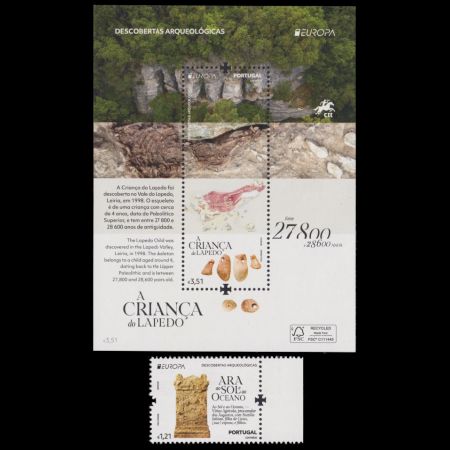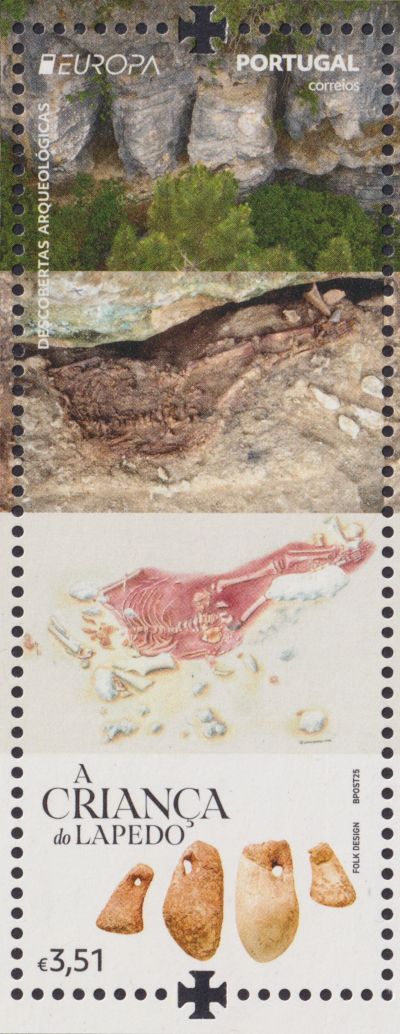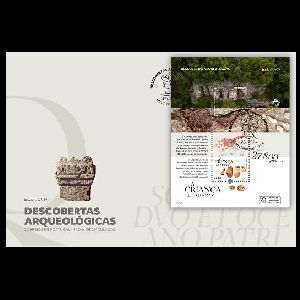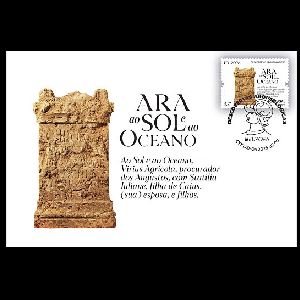Portugal 2025 "Europa 2025 - National Archaeological Discoveries (Mainland Portugal)"
| <prev | back to index | next> |
| Issue Date | 09.05.2025 |
| ID | Michel: 5060, Bl.518 (5061); Scott: Stanley Gibbons: ; Yvert et Tellier: ; Category: An |
| Design | Folk Design Photos: Filipe Patrocínio (Souvenir-Sheet), Joao Zilhao (the stamp) |
| Stamps in set | 2 |
| Value | €1.21 - Altar to the Sun and the Ocean €3.51 - Boy from Lapedo |
| Size (width x height) | stamps: 40.0mm x 30.6mm Souvenir-Sheet: 95.0mm x 125.0mm |
| Layout | Sheet of 10 stamps. Souvenir-Sheet with 1 stamp. |
| Products | FDC x2 |
| Paper | 165g/m2 |
| Perforation | 12.25 x 12.0 |
| Print Technique | Offset Lithography, multicolour |
| Printed by | BPost Philately & Stamps Printing |
| Quantity | stamp: 50.000, Souvenir-Sheet: 20.000 |
| Issuing Authority | CTT – Correios de Portugal S.A. |

On May 9th, 2025, the Postal Authority of Portugal issued three stamp sets under the theme "Europa 2025 – National Archaeological Discoveries", representing the Azores, Madeira, and mainland Portugal. Each set includes a stamp and a souvenir sheet featuring one additional stamp.
The stamp from the mainland issue features the "Altar to the Sun and the Ocean" from Alto da Vigia, Sintra. This site represents a locus sacer (sacred place) from the Roman era, once considered the westernmost boundary of the European continent.
The souvenir sheet from the mainland issue depicts the skeleton, artifacts, and excavation site of the "Lapedo Child."
Another country that issued stamps featuring Neanderthals as part of its Europa 2025 – National Archaeological Discoveries series is Gibraltar.
Lapedo Child (Abrigo do Lagar Velho, Vale do Lapedo, Leiria)

The middle part of the Souvenir-Sheet
 |
| The stamp from the Souvenir-Sheet MiNr.: 5061, Scott: |
The site was found by chance in November 1998 when J. Maurício and P. Souto, surveying the area to verify a report of rock art by student P. Ferreira, investigated a nearby overhang that appeared ideal for Paleolithic habitation.
In December of the same year, a team led by archaeologist João Zilhão excavated the child’s burial. Radiocarbon dating placed the remains within the Gravettian period of the Upper Paleolithic, approximately 27,800 and 28,600 years ago.
The same technique was applied to other materials recovered from the grave, including rabbit bones, red deer bones, and charcoal. The analysis showed that the charcoal and red deer bones were significantly older than the child, suggesting that they were either already present at the site before the burial or had been intentionally reused to position the body within the pit. In contrast, the rabbit bones appear to have been deposited at the same time as the child, possibly as part of a funerary offering.
The child had been carefully laid on their back with the head slightly turned, and the burial pit was intentionally filled with red ochre. Accompanying the body were grave goods, including perforated shells, likely once sewn onto clothing or worn as ornaments, and a red deer tooth pendant.
These items reflect symbolic or ritual behavior and provide insight into early human attitudes toward death. Although parts of the skeleton were disturbed by erosion or animal activity, later reconstruction allowed researchers to analyze body proportions, though this process initially led to some misinterpretations.
This burial is the earliest known Paleolithic funerary context in Portugal and is of great importance for understanding both modern human evolution and the cultural practices of Upper Paleolithic hunter-gatherers in the Iberian Peninsula. The region is also considered one of the final refuges of Neanderthal populations, adding further relevance to the find.
Under the direction of Zilhão and Erik Trinkaus, an international and multidisciplinary team was assembled to analyze and publish the findings.
Today, the Lapedo child remains at the center of ongoing scientific discussion regarding interactions between Neanderthals and early Homo sapiens. The remains were designated a National Treasure in 2021 and are preserved in the National Museum of Archaeology, where replicas and facial reconstructions are sometimes featured in exhibitions for public education.
Products and associated philatelic items
| FDCs | ||
 |
 |
|
| Neither the cachet nor the First Day of Issue postmark features anything related to the Lapedo Child. | ||
References

|
- Technical details and official press release:
CTT, WOPA+. - Lapedo Child:
Wikipedia, Smithsonian magazine.
Acknowledgements
Many thanks to Dr. Peter Voice from Department of Geological and Environmental Sciences, Western Michigan University, for reviewing the draft page and his valuable comments.Additional videos about the Lapedo Child and interbreeding between Neanderthals and modern humans
| <prev | back to index | next> |